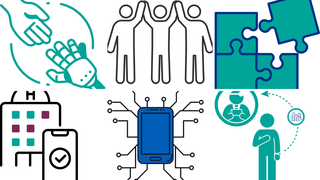AI Skunkworks projects
The NHS AI Lab Skunkworks team ran short-term projects to investigate the use of AI for improving efficiency and accuracy in health and care.
The Skunkworks team looked to help the health and care system, through practical experience, to understand, build, buy, deploy, support, and challenge AI solutions.

Here’s a quick summary of some of the ways we worked on this vision with colleagues in the health and care sector:
Using AI to find optimal placement schedules for nursing students
This project explored whether AI could automatically generate student nurse placement schedules that met the requirements needed by the hospital, while also providing a range of experiences for students.
Deep dive AI workshops - sharing skills and experience
This series of 5 workshops aims to provide organisations with the relevant knowledge and tools to understand how to safely launch an AI experiment in healthcare.
Exploring how to create mock patient data (synthetic data)
This project aimed to provide others with a simple, re-usable way of generating safe and effective synthetic data to be used in technologies that improve health and social care.
Identifying features in CT scans with George Eliot Hospital
This challenge was suggested by a team at George Eliot Hospital who wanted to speed up the analysis of computerised tomography (CT) scans to free up radiologists’ time and help identify tissue growth.
Predicting long hospital stays with Gloucestershire Hospitals
In this project we used admission data and pseudonymised patient records to investigate whether artificial intelligence machine learning methods could identify the patients most at risk of becoming “longstayers” (hospital stays of more than 21 days).
Bed occupancy management with Kettering General Hospital
This project with Kettering General Hospital will look at using AI to improve bed scheduling in hospitals. Using historic bed occupancy data we will apply optimisation methods to create a model that explores different ways of allocating patients to beds.
Developing the health data search engine, Data Lens
In this project, we applied Natural Language Processing (NLP) and other AI technologies to test a prototype data search tool that would be a universal search engine for health and social care data catalogues and metadata.
Predicting negligence claims with NHS Resolution
This project investigated whether it is possible to use machine learning AI to predict the number of claims a trust is likely to receive and learn what drives them in order to improve safety for patients.
Recruitment shortlisting with the NHS England London Talent team
This project looked at the issue of bias in using AI to help compare and review job descriptions and applications. It will test how algorithms perform while placing careful scrutiny on the issues of ethics, equality and inclusiveness.
Identifying and quantifying Parkinson’s Disease using AI on brain slices
This project looked at developing an approach to enhance the identification of biomarkers which are indicative of Parkinson’s Disease, and explore whether automated identification of Parkinson’s Disease in these slices is possible.
Using deep learning to detect adrenal lesions in CT scans
This project explored whether applying AI and deep learning augment the detection of adrenal incidentalomas in patients’ CT scans.
Working with a Trusted Research Environment
This pilot examined using Trusted Research Environments to answer key and important questions for a defined project
Kidney deterioration prediction with University Hospitals Leicester
This project is looking at whether artificial intelligence can help to predict the suddenly deteriorating health of people with acute kidney injury, where your kidneys suddenly stop working properly.
Clinical coding automation with the Royal Free and Kettering General
Data scientists in the AI Lab Skunkworks team and the NHS Transformation Directorate Analytics unit are supporting this project to investigate whether the process of clinical coding (applying standard code words to health records) can be supported by artificial intelligence.